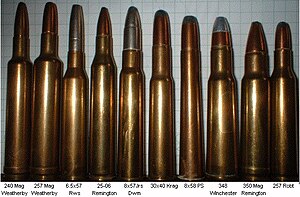| .240 Weatherby Magnum | ||||||||||||||||||||||||
|---|---|---|---|---|---|---|---|---|---|---|---|---|---|---|---|---|---|---|---|---|---|---|---|---|
 .240 Weatherby Magnum (1st from left) | ||||||||||||||||||||||||
| Type | Rifle | |||||||||||||||||||||||
| Place of origin | USA | |||||||||||||||||||||||
| Production history | ||||||||||||||||||||||||
| Designer | Roy Weatherby | |||||||||||||||||||||||
| Designed | 1968 | |||||||||||||||||||||||
| Manufacturer | Weatherby | |||||||||||||||||||||||
| Specifications | ||||||||||||||||||||||||
| Case type | Belted, bottleneck | |||||||||||||||||||||||
| Bullet diameter | .243 in (6.2 mm) | |||||||||||||||||||||||
| Neck diameter | .272 in (6.9 mm) | |||||||||||||||||||||||
| Shoulder diameter | .429 in (10.9 mm) | |||||||||||||||||||||||
| Base diameter | .453 in (11.5 mm) | |||||||||||||||||||||||
| Rim diameter | .472 in (12.0 mm) | |||||||||||||||||||||||
| Case length | 2.496 in (63.4 mm) | |||||||||||||||||||||||
| Overall length | 3.100 in (78.7 mm) | |||||||||||||||||||||||
| Case capacity | 64 gr H2O (4.1 cm3) | |||||||||||||||||||||||
| Rifling twist | 1 in 10 in (250 mm) | |||||||||||||||||||||||
| Primer type | Large rifle | |||||||||||||||||||||||
| Maximum pressure | 65,000 psi (450 MPa) | |||||||||||||||||||||||
| Ballistic performance | ||||||||||||||||||||||||
| ||||||||||||||||||||||||
| Source(s): Hodgdon [1] | ||||||||||||||||||||||||
The .240 Weatherby Magnum was developed in 1968 by Roy Weatherby. In the development of his own .240in/6 mm cartridge, Weatherby was significantly influenced by both the success and the limitations of the .244 H&H Magnum cartridge devised in England by his friend and colleague David Lloyd. It was the last cartridge to be designed by Roy Weatherby. [2]
